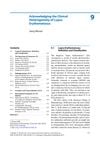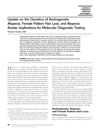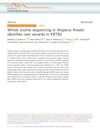TLDR Alopecia areata has a complex genetic basis that was not fully understood as of 2001.
The document from 2001 reviews the understanding of the genetics of alopecia areata (AA), a condition with a significant genetic component, as evidenced by a higher prevalence of AA in first-degree relatives and a 55% concordance rate in monozygotic twins. Epidemiological studies and associations with HLA alleles suggest a complex genetic basis, but specific genes had not been identified. The review discusses the challenges of genetic research in complex diseases and the potential of new methods, such as microarray analyses and the use of SNPs, to uncover the genetic factors of AA. The Human Genome Project is highlighted as a valuable resource for this research, although the genetic basis for AA remained unknown at the time of writing.
127 citations
,
January 2000 in “Journal of Investigative Dermatology” Cytotoxic T cells cause hair loss in chronic alopecia areata.
412 citations
,
January 1998 in “Science” A mutation in the human hairless gene causes alopecia universalis.
203 citations
,
November 1984 in “Journal of the American Academy of Dermatology” Common baldness is likely inherited through multiple genes, not just one.
78 citations
,
July 1984 in “Journal of Investigative Dermatology”
 60 citations
,
September 2015 in “Expert Review of Clinical Immunology”
60 citations
,
September 2015 in “Expert Review of Clinical Immunology” Lymphocytes, especially CD8+ T cells, play a key role in causing alopecia areata, and targeting them may lead to new treatments.
19 citations
,
July 2020 in “EBioMedicine” A gene variant increases the risk of a type of hair loss by affecting hair protein production.

Lupus is a complex disease that requires personalized treatment because it varies greatly between individuals.
 11 citations
,
November 2012 in “Seminars in Cutaneous Medicine and Surgery”
11 citations
,
November 2012 in “Seminars in Cutaneous Medicine and Surgery” Genetic factors affect hair loss, and molecular testing may help predict, diagnose, and treat it.
 9 citations
,
February 2022 in “Nature communications”
9 citations
,
February 2022 in “Nature communications” Rare changes in the KRT82 gene are linked to a higher risk of Alopecia Areata.




